Intel Architecture Day 2021: Alder Lake, Golden Cove, and Gracemont Detailed
by Dr. Ian Cutress & Andrei Frumusanu on August 19, 2021 9:00 AM ESTGracemont Microarchitecture (E-Core) Examined
The smaller core as part of Intel’s hybrid Alder Lake design is called an E-core, and is built on the Gracemont microarchitecture. It forms part of Intel’s Atom family of processors, and is a significant microarchitectural jump over the previous Atom core design called Tremont.
- 2008: Bonnell
- 2011: Saltwell
- 2013: Silvermont
- 2015: Airmont
- 2016: Goldmont
- 2017: Goldmont Plus
- 2020: Tremont
- 2021: Gracemont
Based on Intel’s diagrams, the company is pitching that the size of its Golden Cove core means that in the space it would normally fit one of its P-core designs, it can enable a four core cluster of E-cores along with a shared 4MB L2 cache between them.
For performance, Intel has some pretty wild claims. It splits them up into single thread and multi-thread comparisons using SPECrate2017_int.
When comparing 1C1T of Gracemont against 1C1T of Skylake, Intel’s numbers suggest:
- +40% performance at iso-power (using a middling frequency)
- 40% less power* at iso-performance (peak Skylake performance)
*'<40%' is now stood to mean 'below 40 power'
When comparing 4C4T of Gracemont against 2C4T of Skylake, Intel’s numbers suggest:
- +80% performance peak vs peak
- 80% less power at iso performance)peak Skylake performance
We pushed the two Intel slides together to show how they presented this data.
By these graphics it looks like that for peak single thread, we should see around +8% better than Skylake performance while consuming just over half the power – look for Cinebench R20 scores for one Gracemont thread around 478 then (Skylake 6700K scored 443). With +8% for single thread in mind, the +80% in MT comparing 4 cores of Gracemont to two fully loaded Skylake cores seems a little low – we’ve got double the physical cores with Gracemont compared to Skylake here. But there’s likely some additional performance regression with the cache structure on the new Atom core, which we’ll get to later on this page.
These claims are substantial. Intel hasn’t compared the new Atom core generation on generation, because it felt that having AVX2 support would put the new Atom at a significant advantage. But what Intel is saying with these graphs is that we should expect better-than Skylake performance at much less power. We saw Skylake processors up to 28 cores in HEDT – it makes me wonder if Intel might not enable its new Atom core for that market. If that’s the case, where is our 64-core Atom version for HEDT? I’ll take one.
Front End
The big item about the Tremont front end of the core was the move to dual three-wide decode paths, enabling two concurrent streams of decode that could support 3 per cycle. That still remains in Gracemont, but is backed by a double-size 64 KB L1 Instruction cache. This ties into the branch predictor which enables prefetchers at all cache levels, along with a 5000-entry branch target cache which Intel says in improved over the previous generation.
Back on the decoder, Intel supports on-demand decode which stores a history of previous decodes in the instruction cache and if recent misses are recalled at the decode stage, the on-demand stream will pull directly from the instruction cache instead, saving time – if the prefetch/decode works, the content in the instruction cache is updated, however if it is doing poorly then the scope is ‘re-enabled for general fetches’ to get a better understanding of the instruction flow. This almost sounds like a micro-op cache without having a physical cache, but is more to do about instruction streaming. Either way, the decoders can push up to six uops into the second half of the front end.
For Gracemont, the reorder buffer size has increased from 208 in Tremont to 256, which is important aspect given that Gracemont now has a total of 17 (!) execution ports, compared to eight in Tremont. This is also significantly wider than the execution capabilities of Golden Cove's 12 ports, related to the disaggregated integer and FP/vector pipeline design. However, despite that width, the allocation stage feeding into the reservation stations can only process five instructions per cycle. On the return path, each core can retire eight instructions per cycle.
Back End
So it’s a bit insane to have 17 execution ports here. There are a lot of repeated units as well, which means that Gracemont is expecting to see repeated instruction use and requires the parallelism to do more per cycle and then perhaps sit idle waiting for the next instructions to come down the pipe. Overall we have
- 4 Integer ALUs (ALU/Shift), two of which can do MUL/DIV
- 4 Address Generator Units, 2 Load + 2 Store
- 2 Branch Ports
- 2 Extra Integer Store ports
- 2 Floating Point/Vector store ports
- 3 Floating Point/Vector ALUs: 3x ALUs, 2x AES/FMUL/FADD, 1x SHA/IMUL/FDIV
It will be interesting to see exactly how many of these can be accessed simultaneously. In previous core designs a lot of this functionality would be enabled though the same port – even Alder Lake’s P-core only has 12 execution ports, with some ports doing double duty on Vector and Integer workloads. In the P-core there is a single scheduler for both types of workloads, whereas in the E-core there are two separate schedulers, which is more akin to what we see on non-x86 core designs. It’s a tradeoff in complexity and ease-of-use.
The back-end is support by a 32 KiB L1-Data cache, which supports a 3-cycle pointer chasing latency and 64 outstanding cache misses. There are two load and two store ports, which means 2x16 byte loads and 2 x 16 byte stores to the L1-D.
There is also has a shared 4 MB L2 cache across all four E-cores in a cluster with 17-cycle latency. The shared L2 cache can support 64 bytes per cycle read/write per core, which Intel states is sufficient for all four cores. The new L2 supports up to 64 outstanding misses to the deeper memory subsystem – which seems fair, but has to be shared amongst the 4 cores.
Intel states that it has a Resource Director that will arbitrate cache accesses between the four cores in a cluster to ensure fairness, confirming that Intel are building these E-cores in for multi-threaded performance rather than latency sensitive scenarios where one thread might have priority.
Other Highlights
As the first Atom core to have AVX2 enabled, there are two vector ports that support FMUL and FADD (port 20 and port 21), which means that we should expect peak performance compared to previous Atoms to be substantial. The addition of VNNI-INT8 over the AVX unit means that Intel wants these E-cores to enable situations where high inference throughput is needed, such as perhaps video analysis.
Intel was keen to point out that Gracemont has all of its latest security features including Control Flow Enhancement Technology (CET), and virtualization redirects under its VT-rp feature.
Overall, Intel stated that the E-cores are tuned for voltage more than anything else (such as performance, area). This means that the E-cores are set to use a lot less power, which may help in mobile scenarios. But as mentioned before on the first page, it will depend on how much power the ring has to consume in that environment - it should be worth noting that each four core Atom cluster only has a single stop on the full ring in Alder Lake, which Intel says should not cause congestion but it is a possibility – if each core is fully loaded, there is only 512 KB of L2 cache per core before making the jump to main memory, which indicates that in a fully loaded scenario, that might be a bottleneck.


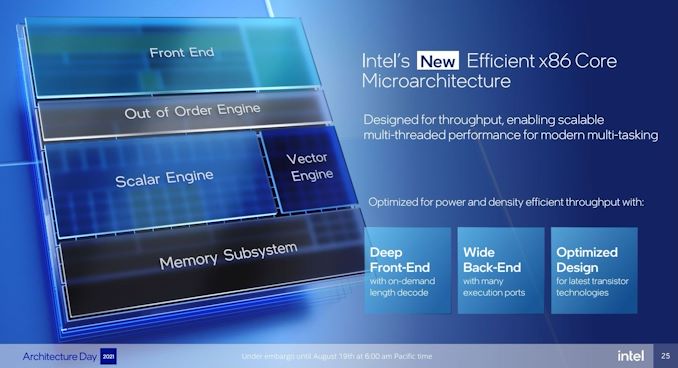
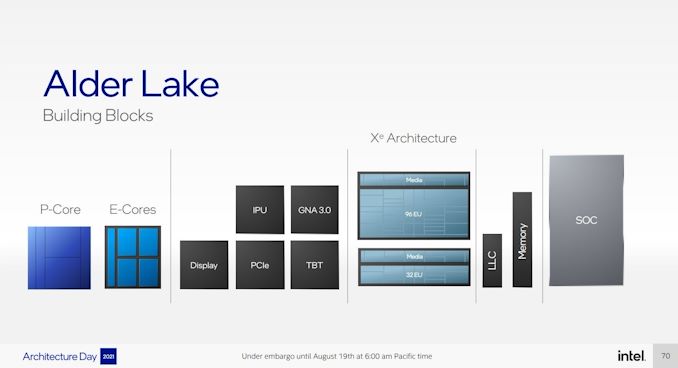

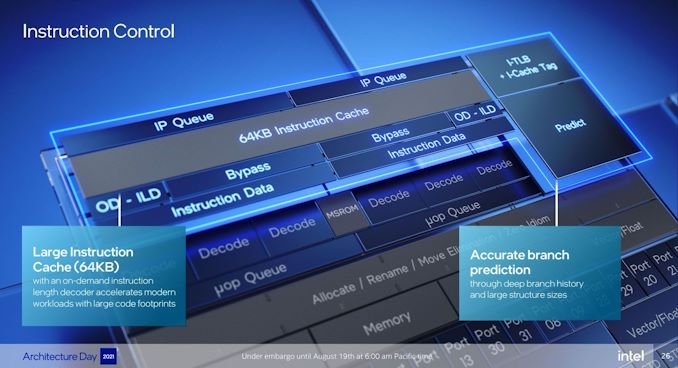
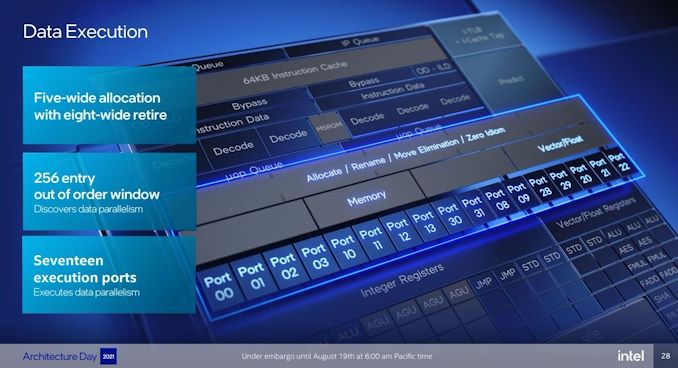
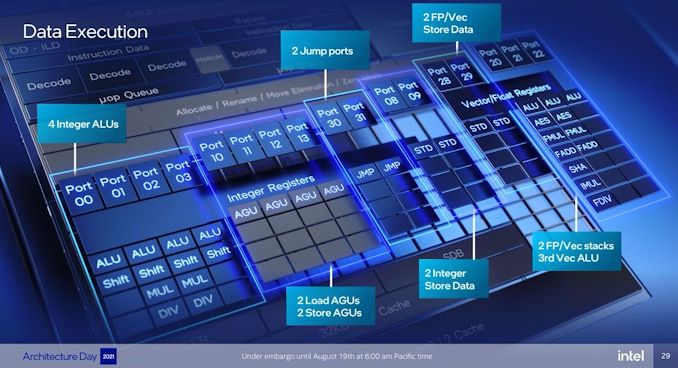









223 Comments
View All Comments
WaltC - Thursday, August 19, 2021 - link
Ditto. Wake me when the CPUs ship. Until then, ZZZZ-Z-Z-zzzz. You would think that most people would have grown tired by now of seeing advance info from Intel that somehow never accurate describes the products that do ship.Nice to see Anandtech using Intel PR marketing description instead of describing the process node in nm--just because Intel decides that accuracy in advertising really isn't important. Every time I see "Intel's process 7" I cringe...;) indicates the extent to which Intel is rattled these days, I guess.
SarahKerrigan - Thursday, August 19, 2021 - link
"The process node in nm" - which structure size should determine this? What structure's geometry in TSMC is 7nm?kwohlt - Thursday, August 19, 2021 - link
There's nothing inaccurate at all, considering "TSMC 7nm" and "Intel 10nm" and it's extensions are product names and not measurements. If the next, yet to be released node known as Intel 7 offers a 20% performance/watt improvement over Intel 10nm SuperFin, then that's an improvement metric large enough to justify lowering the number in the name, just as all the other fabs do.mode_13h - Thursday, August 19, 2021 - link
> Nice to see Anandtech using Intel PR marketing description instead of> describing the process node in nm
More goes into a fab process than just density. Also, because density can be computed different ways and Intel doesn't exactly release the raw data you'd need to properly compute, they have no real choice but to report the manufacturing process as Intel has named it.
Of course, they should always do so with a link to their article describing what's known about Intel 7.
DannyH246 - Thursday, August 19, 2021 - link
Completely agree. We've had so many articles like this over the last 5 years its not even funny. Never fear though www.IntelTech.com will be here to dutifully report on it as the next best thing.MetaCube - Thursday, August 19, 2021 - link
Cringe takeWereweeb - Thursday, August 19, 2021 - link
This will finally use 10nm, so I doubt it. I'm worried about the memory bandwidth and latency tho.I'm hopeful that IBM manages to improve upon MRAM until it's a suitable SRAM replacement. DRAM isn't keeping up, so we need more, cheaper L3 cache as a buffer.
TheinsanegamerN - Friday, August 20, 2021 - link
Well it’s a good thing that ddr5 with clock speeds in excess of double what ddr4 can offer, with promising of results triple that of ddr4, are arriving as we speak.mode_13h - Saturday, August 21, 2021 - link
DDR5 will only help with bandwidth. Every time a new DDR standard comes along, latency (measured in ns) ends up being about the same or worse.Bigger L3 helps with both bandwidth and latency, but at a cost (in both $ and W).
Spunjji - Monday, August 23, 2021 - link
If their claims about 15% better power characteristics for 7 are true - and they're not based on some cherry-picked measurements at some unspecified mid-power-level - then they might have the headroom to maintain clocks even with the expanded structures.With Ice Lake having been such a flop in this regard, though - and Tiger taking as much as it gave away, depending on power level - I'm with you on waiting to see what they deliver before I get excited. That's in shipping products, too - not some tweaked trial notebook with an unlocked TDP and 100% fan speeds...